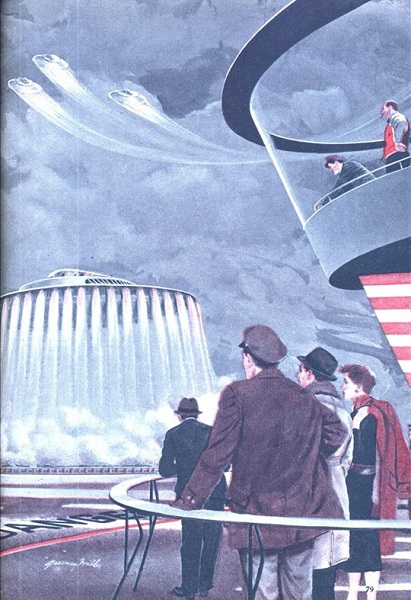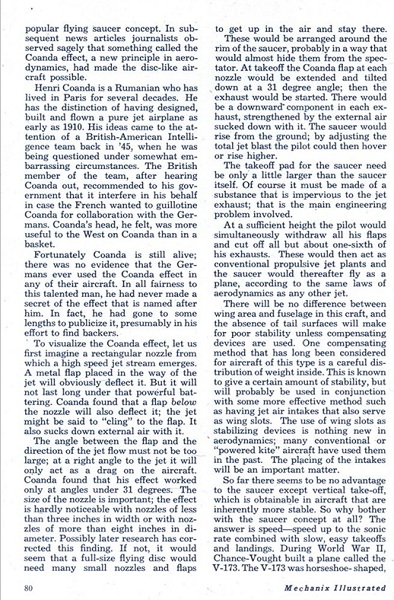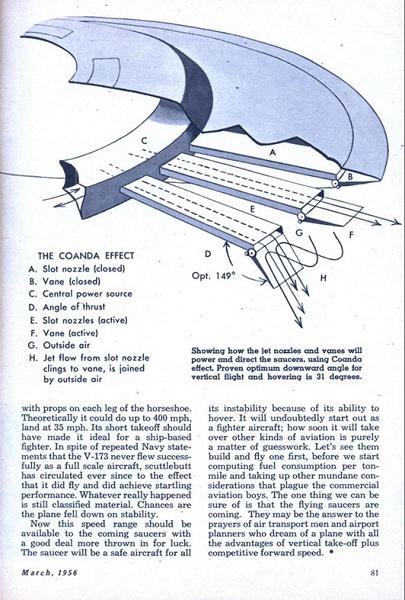It looks like you're using an Ad Blocker.
Please white-list or disable AboveTopSecret.com in your ad-blocking tool.
Thank you.
Some features of ATS will be disabled while you continue to use an ad-blocker.
share:
Officially, aliens have never existed but flying saucers very nearly did. The National Archives has recently published never-before-seen schematics and details of a 1950s military venture, called Project 1794, which aimed to build a supersonic flying saucer.
The newly declassified materials show the U.S. Air Force had a contract with a now-defunct Canadian company to build an aircraft unlike anything seen before. Project 1794 got as far as the initial rounds of product development and into prototype design. In a memo dating from 1956 the results from pre-prototype testing are summarized and reveal exactly what the developers had hoped to create.
The saucer was supposed to reach a top speed of “between Mach 3 and Mach 4, a ceiling of over 100,000 ft. and a maximum range with allowances of about 1,000 nautical miles,” according to the document.
If the plans had followed through to completion they would have created a saucer, which could spin through the Earth’s stratosphere at an average top speed of about 2,600 miles per hour. Wow. It was also designed to take off and land vertically (VTOL), using propulsion jets to control and stabilize the aircraft. Admittedly the range of 1,000 nautical miles seems limited in comparison to the other specifications – but if you’d hopped on the disk in New York it could’ve had you in Miami within about 24 minutes.
The document also hints that the product development seemed to be going better than planned; “the present design will provide a much superior performance to that estimated at the start of contract negotiations.”
It begs the question – why was the project dropped? Why aren’t wars being fought with flying saucers? The cost of continuing to prototype was estimated at $3,168,000, which roughly translates to about $26.6 million in today’s money and wouldn’t have been an insane price for such advanced technology. The problem with the other flying saucers developed under the same program (see video) is pretty clear. They didn’t get anywhere near 100,000 feet in altitude, more like five or six if you were lucky – so the military finally pulled the plug in 1960.
Source
Check the link for some of the schematics.
This is exciting. It reminded me of the witness accounts given to us by Jack Pickett who stumbled across some flying saucers with 'USAF' written on them in a hangar whilst writing a piece for a magazine. Here is that story if you're not familiar with it
reply to post by Shino
Good thing it ended there and nothing like this is going on today that we are gonna find our about in 60 years.
Good thing it ended there and nothing like this is going on today that we are gonna find our about in 60 years.
edit on 6-10-2012 by
Screwed because: (no reason given)
Where did they got the idea to build flying saucer in the first place ? Why not flying box ?
I got to laugh at the propulsion type used, these people are desperate at that time I guess.
All things point to UFO existence and yet "flying saucers" not exist, yeah, like I would believe that.
Its build like a saucer because theres a reason and propulsion jet is not that reason.
I got to laugh at the propulsion type used, these people are desperate at that time I guess.
All things point to UFO existence and yet "flying saucers" not exist, yeah, like I would believe that.
Its build like a saucer because theres a reason and propulsion jet is not that reason.
edit on 6-10-2012 by NullVoid because: (no reason
given)
reply to post by Shino
yep yep! on the military history channel there was a program called "The Nazi UFO Conspiracy"
it was VERY interesting and VERY well put together. I recommend it to anyone!
yep yep! on the military history channel there was a program called "The Nazi UFO Conspiracy"
it was VERY interesting and VERY well put together. I recommend it to anyone!
Nice catch!
So they got far enough in the known development to say "Oh my God! It WORKS!" then the powers that be said.... "uh oh, the damn thing works!" and threw enough classification on the whole thing to make it vanish as if nothing after that stage ever existed.
I think sightings by everyone from bums on skid row to Mayors and Police Officers in the 60 or so years since confirms they never stopped. Just my take on it...and again, nice catch to see more than I'd seen on History Channel about the first little prototypes that got a whopping 3-4 feet off the ground with giant fans for propulsion.
(OP Story)
The newly declassified materials show the U.S. Air Force had a contract with a now-defunct Canadian company to build an aircraft unlike anything seen before. Project 1794 got as far as the initial rounds of product development and into prototype design. In a memo dating from 1956 the results from pre-prototype testing are summarized and reveal exactly what the developers had hoped to create.
So they got far enough in the known development to say "Oh my God! It WORKS!" then the powers that be said.... "uh oh, the damn thing works!" and threw enough classification on the whole thing to make it vanish as if nothing after that stage ever existed.
I think sightings by everyone from bums on skid row to Mayors and Police Officers in the 60 or so years since confirms they never stopped. Just my take on it...and again, nice catch to see more than I'd seen on History Channel about the first little prototypes that got a whopping 3-4 feet off the ground with giant fans for propulsion.
edit on 6-10-2012 by Wrabbit2000 because: (no reason given)
Change the numbers around and project 1794 becomes project 1947! Might as well call it project Roswell!
I'm not sure how recent this release was but Project 1794 has been known about for quite some time as the successor to the Avrocar , here's some
More information and pictures .
TinWiki: Avrocar
Wonder where they got the idea from
TinWiki: Avrocar
Wonder where they got the idea from
While "Project 1794" or "Project Silver Bug" was classified, there was mention of it made back in 1950s. The Magazine "Royal Air Force Flying
Review" from 1955 had an artists' conception of the vehicle, called MX-1794, or "Silverbug"
greyfalcon.us...
greyfalcon.us...
reply to post by Shino
The United States amongst others has been trying to create "UFO's" or Antigravity crafts that can travel faster than the speed of light for over 100 years! And actively suppressing public science from going anywhere near this area.
Some of their attempts have been more successful than others. The most successfully attempts we had.... help building.
John Searl tried to conquer Anti Gravity. As did Otis.T Carr, Nikola Tesla, Ed Leedskalnin.
But ok Ile believe this article that says they stopped looking into that area...... psssh weak lies. It would have been dropped to either develop it more in secret. Or because a different project was showing more promise in this area and funding was redirected.
But they have UFO's now. I think China do also. And Antarctica. Who knows who those ones belong to? Nazis apparently.
The United States amongst others has been trying to create "UFO's" or Antigravity crafts that can travel faster than the speed of light for over 100 years! And actively suppressing public science from going anywhere near this area.
Some of their attempts have been more successful than others. The most successfully attempts we had.... help building.
John Searl tried to conquer Anti Gravity. As did Otis.T Carr, Nikola Tesla, Ed Leedskalnin.
But ok Ile believe this article that says they stopped looking into that area...... psssh weak lies. It would have been dropped to either develop it more in secret. Or because a different project was showing more promise in this area and funding was redirected.
But they have UFO's now. I think China do also. And Antarctica. Who knows who those ones belong to? Nazis apparently.
edit on 6-10-2012 by
Mandrakerealmz because: (no reason given)
reply to post by NullVoid
In WW2 the Germans experimentet with flying saucer type craft. I would bet they at least got the idea from them? Or they might have seen some aliens... You decide!
In WW2 the Germans experimentet with flying saucer type craft. I would bet they at least got the idea from them? Or they might have seen some aliens... You decide!
I find it amusing.
To think that this and the likes of the avrocar were the best that "they" could could come up with.
Come on usaf you are not fooling ole liejunkie.
Doesn't anybody else find it strange that after all this time and countless trillions spent we are still using turbine engines.
"They" must have some stagnant r&d methods.lol
To think that this and the likes of the avrocar were the best that "they" could could come up with.
Come on usaf you are not fooling ole liejunkie.
Doesn't anybody else find it strange that after all this time and countless trillions spent we are still using turbine engines.
"They" must have some stagnant r&d methods.lol
Originally posted by NullVoid
Where did they got the idea to build flying saucer in the first place ? Why not flying box ?
I got to laugh at the propulsion type used, these people are desperate at that time I guess....
I agree. The curious thing is that someone decided to build a saucer, just for the heck of it. If you're going to employ a jet propulsion system, why not just build a regular plane? That's what's so funny about it.
The 'UFO' is not special because it's a circular shape, it's special because it's extra terrestrial!
Originally posted by liejunkie01
I find it amusing.
To think that this and the likes of the avrocar were the best that "they" could could come up with.
Come on usaf you are not fooling ole liejunkie.
Doesn't anybody else find it strange that after all this time and countless trillions spent we are still using turbine engines.
"They" must have some stagnant r&d methods.lol
What is REALLY amusing is that there are so many people who believe that the Nazis had anti-gravity flying saucers and that the USAF got that technology, or has back engineered that "anti-gravity" technology from crashed flying saucers.
This despite the fact that 50 years later, there is no credible evidence of this. Made most obvious by the fact that EVERY new aircraft or drone still uses a variation on "pushing air" propulsion, like a propeller, turbine, or rocket.
Originally posted by hesse
IS this some variation of this great device?
Yes! And laugh as we might, there was a successful deployment off this technology. Add a skirt around the bottom and you have a hovercraft.
reply to post by bluestreak53
I am not one of the Nazi UFO believers.
There is a member here that makes a pretty good case about the Nazi bell being a uranium enricher.
It sounds more logical than a UFO.
I am not one of the Nazi UFO believers.
There is a member here that makes a pretty good case about the Nazi bell being a uranium enricher.
It sounds more logical than a UFO.
edit on 11-10-2012 by liejunkie01 because: i hate rhis phone
A similar article from 1956 some may be interested in...










edit on 18-10-2012 by Drunkenparrot because: (no reason given)
Are there plans to digitize all of the files, or are we just going to get those 4 images?
Originally posted by bluestreak53
Originally posted by liejunkie01
I find it amusing.
To think that this and the likes of the avrocar were the best that "they" could could come up with.
Come on usaf you are not fooling ole liejunkie.
Doesn't anybody else find it strange that after all this time and countless trillions spent we are still using turbine engines.
"They" must have some stagnant r&d methods.lol
What is REALLY amusing is that there are so many people who believe that the Nazis had anti-gravity flying saucers and that the USAF got that technology, or has back engineered that "anti-gravity" technology from crashed flying saucers.
This despite the fact that 50 years later, there is no credible evidence of this. Made most obvious by the fact that EVERY new aircraft or drone still uses a variation on "pushing air" propulsion, like a propeller, turbine, or rocket.
Absolutely agree.
I have an interest in aviation history and have dug into the Nazi saucer myth in depth with the help of resources I have garnered through the aviation community.
With a little work, the timeline of the evolution of the story is easily exposed going back to the claims of an ex-Regia Aeronautica officer's late 40's interview for a magazine claiming to have seen an RLM project resembling a disc based on conventional "nuts and bolts" engineering during the war.
After a couple of fictionalised accounts of one-upmanship catering to the UFO crowd were published in the 60's, the white supremacy movement latched onto the idea and propagated it for years.
More recently there has been a resurgence with the addition of the entirely fictional "Die Glock" with the octagonal base of an old industrial cooling tower offered as proof.
It's ridiculous but people want to believe in the fantastic.
More proof that P.T. Barnum was correct
new topics
-
Why isn't Psychiatry involved?
Social Issues and Civil Unrest: 4 hours ago -
Help in song interpretation
Music: 5 hours ago -
FEMA Head Admits Agency Skipped 20 Homes with Trump Signs
Mainstream News: 8 hours ago -
Yet another Hack...
Rant: 9 hours ago
top topics
-
Yet another Hack...
Rant: 9 hours ago, 12 flags -
FEMA Head Admits Agency Skipped 20 Homes with Trump Signs
Mainstream News: 8 hours ago, 12 flags -
U.S. Closes Kyiv Embassy Over ‘Significant Air Attack’ Intelligence
World War Three: 17 hours ago, 10 flags -
Gaetz ethics investigation results "hacked".
US Political Madness: 13 hours ago, 10 flags -
Help in song interpretation
Music: 5 hours ago, 1 flags -
Why isn't Psychiatry involved?
Social Issues and Civil Unrest: 4 hours ago, 0 flags
active topics
-
Post A Funny (T&C Friendly) Pic Part IV: The LOL awakens!
General Chit Chat • 7801 • : PorkChop96 -
Russia Ukraine Update Thread - part 3
World War Three • 6835 • : Oldcarpy2 -
U.S. Closes Kyiv Embassy Over ‘Significant Air Attack’ Intelligence
World War Three • 41 • : Imhere -
Well, here we go red lines crossed Biden gives the go ahead to use long range missiles
World War Three • 312 • : Oldcarpy2 -
Famous Catholic Exorcist Visits Mir-a-Lago
US Political Madness • 19 • : chr0naut -
-@TH3WH17ERABB17- -Q- ---TIME TO SHOW THE WORLD--- -Part- --44--
Dissecting Disinformation • 3331 • : brewtiger123 -
Why isn't Psychiatry involved?
Social Issues and Civil Unrest • 3 • : berbofthegreen -
Help in song interpretation
Music • 1 • : FullHeathen -
President-Elect DONALD TRUMP's 2nd-Term Administration Takes Shape.
Political Ideology • 226 • : WeMustCare -
FEMA Head Admits Agency Skipped 20 Homes with Trump Signs
Mainstream News • 10 • : BingoMcGoof


